How can the average number of emitted secondary electrons emitted be a non-integer value? Does this mean that if the potential between two dynodes is 100V, for example, that 2.75 electrons are emitted? Electrons are believed to be elementary particles, which means that they cannot be broken into smaller pieces. It does not make sense to have a fraction of an electron. The data we collected were the averagenumber of electrons emitted per incident electron. If the potential between two dynodes is 110V, then on average,2.75 electrons are emitted. This means that some of the time three electrons are emitted, sometimes two electrons, sometimes even one or four electrons, averaging to 2.75. |  |
||||
|
|||||

